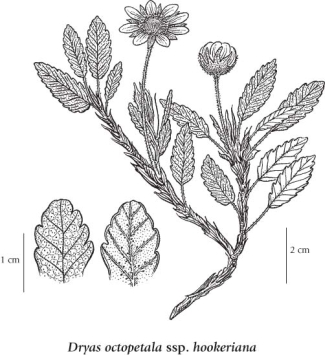Click on the image below to view an
expanded illustration for this species.

|
General:
Prostrate shrub from a woody stem-base; stems trailing, freely branching and rooting, forming dense mats.
Leaves:
Alternate, evergreen, the leaf blades oblong-egg-shaped to linear-lanceolate, 0.8-4 cm long, broadest near the middle, blunt to rounded at the tip, rounded to squared-off or somewhat heart-shaped at the stalked base; the margins coarsely blunt-toothed, rolled under; strongly wrinkled, green and mostly smooth but often warty-glandular above, densely white woolly-hairy (rarely nearly smooth) below; midvein below with gland-tipped brown hairs and/or brown scales with long much-branched white hairs; dead leaves withering but the remains persisting.
Flowers:
Solitary, erect on leafless, 5- to 20-cm tall stalks, the stalks more or less woolly and also stalked-glandular above; corollas white, 2-3 cm across, the petals 8 to 10, oblong to elliptic, spreading, 8-17 mm long; calyces white-woolly and with some black, glandular hairs, the 8 to 10 lobes oblong-lanceolate, 4-8 mm long; ovaries superior; stamens numerous, the filaments smooth.
Fruits:
Achenes, numerous, about 3 mm long, with long (to 3 or 4 cm), feathery styles.
Notes:
Hybrids between this species and Dryas integrifolia can occur where the two species grow together. To separate this species from D. octopetala look for egg-shaped leaves, broadest near or below middle; densely white-woolly beneath.
Source: The Illustrated Flora of British Columbia
|
